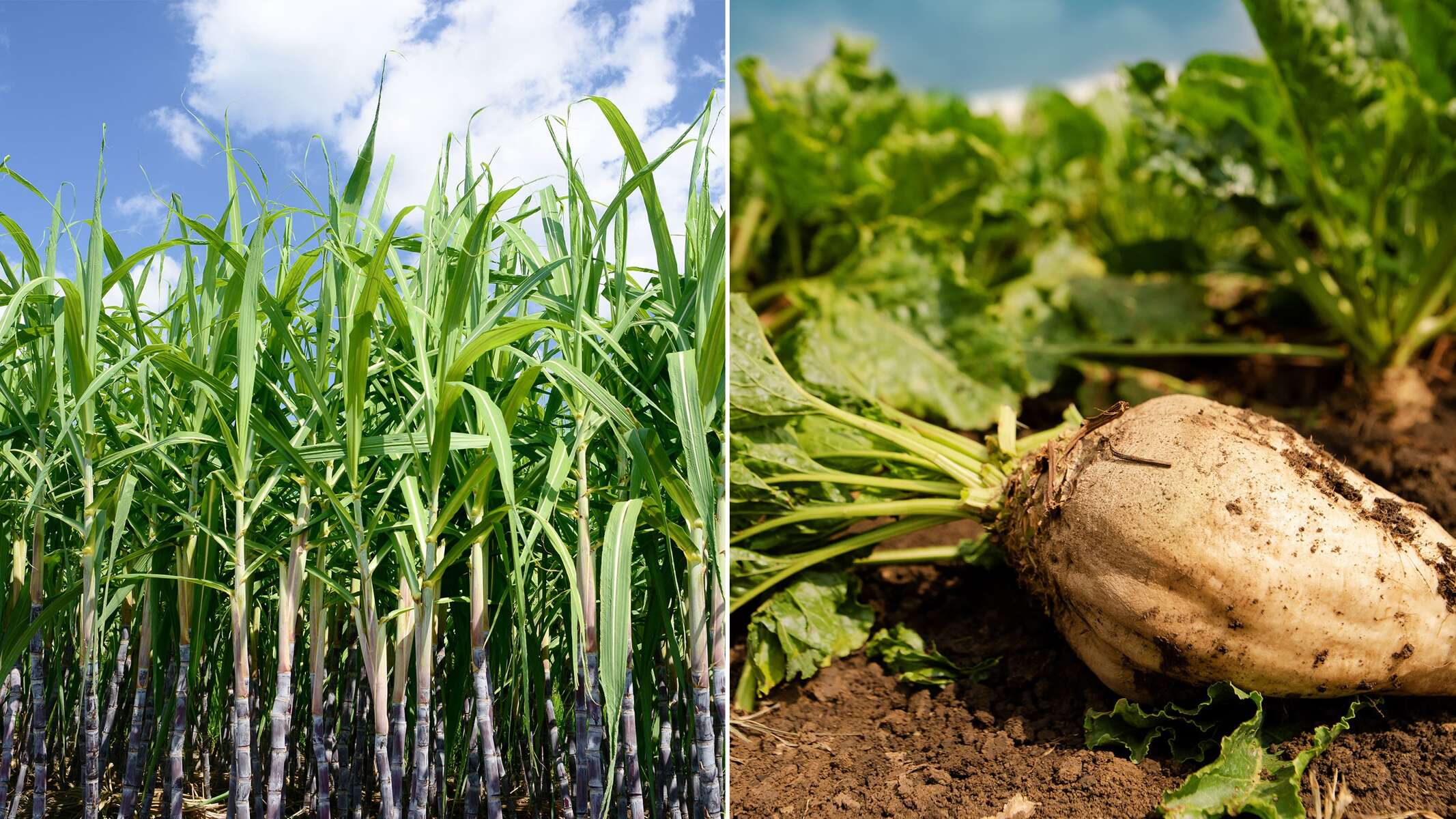Ten major variations in cultivation practices of Sugar beet vs sugar cane
Comprehending Sugar Beet Vs Sugar Cane: a Deep Study Their Handling and Applications
The comparison between sugar beet and sugar cane discloses essential differences in their processing and usage. Each crop has one-of-a-kind cultivation techniques that affect its geographic circulation. Sugar beets are primarily refined right into granulated sugar for various food items, while sugar cane is frequently made use of in beverages. Recognizing these differences clarifies their duties in the food industry and their economic value. The more comprehensive effects of their farming and processing warrant further expedition.
Summary of Sugar Beet and Sugar Cane
Sugar beet and sugar cane are two key sources of sucrose, each contributing substantially to the global sugar supply. Sugar beet is an origin veggie, typically gathered in cooler climates, while sugar cane is a tall grass that prospers in warmer tropical and subtropical regions. The handling of sugar beet entails cleaning, slicing, and drawing out juice, followed by purification and formation. In comparison, sugar cane handling includes crushing the stalks to remove juice, which is after that cleared up and concentrated right into sugar crystals.
Both plants are rich in sucrose, but their make-up varies somewhat, with sugar cane generally having a greater sugar web content. Each source also plays a duty in biofuel manufacturing, with sugar beet commonly utilized for ethanol. While both are important for various applications, their distinctive development demands and handling approaches influence their respective payments to the sugar market.
Geographical Distribution and Cultivation Problems
Sugar beet and sugar cane are cultivated in distinctive geographical regions, influenced by their details climate and soil requirements. Sugar cane grows in tropical climates, while sugar beet is much better fit for temperate areas with cooler temperature levels. Comprehending these cultivation problems is vital for optimizing manufacturing and making sure quality in both plants.
Global Expanding Regions
While both sugar beet and sugar cane are essential resources of sugar, their worldwide growing regions differ significantly due to climate and dirt needs. Sugar beet prospers generally in temperate areas, with substantial production concentrated in Europe, The United States And Canada, and components of Asia. These areas normally feature well-drained, abundant soils that support the crop's development cycle. On the other hand, sugar cane is mostly grown in exotic and subtropical areas, with significant manufacturing hubs situated in Brazil, India, China, and Thailand. This plant flourishes in warm, damp atmospheres that facilitate its development. The geographical distribution of these 2 crops highlights the adaptability of sugar cane to warmer environments, while sugar beet remains reliant on cooler, pleasant conditions for peak growth.
Climate Requirements
The environment needs for sugar beet and sugar cane differ markedly, mirroring their adjustment to unique ecological problems. Sugar beet prospers in warm environments, needing awesome to moderate temperatures, ideally varying from 15 ° C to 20 ° C. It is delicate to frost and take advantage of well-distributed rainfall throughout its expanding period. This crop is normally cultivated in areas such as Europe and The United States And Canada.
On the other hand, sugar cane embellishments in tropical and subtropical climates, favoring warmer temperature levels between 20 ° C and 30 ° C - Sugar beet vs sugar cane. It requires bountiful sunshine and regular rains, making it fit to locations like Brazil, India, and Southeast Asia. The different climate preferences of these crops noticeably influence their geographical circulation and farming methods
Soil Preferences
Although both sugar beet and sugar cane call for certain dirt conditions to flourish, their preferences differ considerably. Sugar beetroots prosper in well-drained, fertile soils rich in organic matter, with a pH varying from 6.0 to 7.5. These problems are commonly located in pleasant regions, particularly in Europe and North America. On the other hand, sugar cane likes deep, productive soils with excellent water drainage and a somewhat acidic to neutral pH (6.0 to 7.0) This crop is mainly grown in exotic and subtropical climates, such as Brazil, India, and Australia. The geographic circulation of these plants reflects their dirt choices, as sugar beets are matched for cooler climates, while sugar cane thrives in warmer, extra damp environments.
Harvesting and Handling Techniques
In checking out the harvesting and processing techniques for sugar beet and sugar cane, unique methods arise for each plant. The comparison of harvesting approaches exposes variations in performance and labor demands, while extraction methods highlight differences in the initial processing phases. Additionally, recognizing the refining processes is necessary for evaluating the top quality and return of sugar generated from these two sources.
Gathering Techniques Comparison
When thinking about the collecting techniques for sugar beet and sugar cane, distinctive methods emerge that show the distinct characteristics of each plant. Sugar beet collecting generally entails mechanical methods, making use of specialized farmers that uproot the beetroots from the ground, removing tops and soil in the process. This strategy allows for effective collection and lessens plant damage. In contrast, sugar cane harvesting can be either hands-on or mechanical. Manual harvesting includes employees cutting the stalks short, while mechanical harvesting utilizes huge equipments that reduced, cut, and collect the cane in one procedure. These distinctions in gathering approaches highlight the flexibility of each plant to its growing atmosphere and the farming methods prevalent in their corresponding areas.
Extraction Methods Overview
Extraction methods for sugar production differ substantially in between sugar beet and sugar cane, reflecting their unique qualities and processing demands. Sugar beets are normally collected making use of mechanical farmers that cut the roots from the ground, complied with by washing to remove soil. The beetroots are after that cut into thin pieces, called cossettes, to facilitate the removal of sugar via diffusion or warm water extraction. On the other hand, sugar cane is typically harvested by hand or machine, with the stalks reduced short. After gathering, sugar cane goes through crushing to extract juice, which is after that made clear and focused. These extraction methods highlight the distinct strategies made use of based upon the source plant's physical directory attributes and the desired performance of sugar extraction.
Refining Processes Explained
Refining procedures for sugar from both sugar beet and sugar cane entail a number of necessary actions that ensure the last product is pure and suitable for intake. Originally, the raw juice drawn out from either resource goes through information, where pollutants are removed making use of lime and warmth. Following this, the juice is evaporated to focus the sugars. For sugar beets, the process commonly includes carbonatation, while sugar cane may undertake an extra straightforward condensation approach. As soon as concentrated, the syrup goes through crystallization, generating raw sugar. Lastly, the raw sugar is purified with centrifugation and additional refining, leading to the white granulated sugar typically found on store shelves. Each action is vital in guaranteeing item quality and security for customers.
Nutritional Profiles and Wellness Impacts

Health and wellness effects related to both resources largely stem from their high sugar material. Extreme usage of sucrose from either resource can lead to weight gain, dental issues, and enhanced danger of persistent illness such as diabetes mellitus and cardiovascular disease. Sugar cane juice, usually eaten in its natural form, may offer extra anti-oxidants and phytonutrients contrasted to polished sugar beet items. Inevitably, moderation is type in using both sugar beet and sugar cane in diet plans to alleviate prospective wellness risks.
Economic Significance and Worldwide Manufacturing
The financial significance of sugar beet and sugar cane is significant, since both crops play essential roles in the international agricultural landscape. Sugar cane, mainly grown in exotic and subtropical areas, represent around 75% of the globe's sugar manufacturing. Countries like Brazil and India are leading producers, adding considerably to their national economic climates with exports and regional usage.

The global sugar market is valued at billions of dollars, influenced by various factors including climate, trade plans, and customer demand. Appropriately, both sugar beet and sugar cane are essential for economic stability and development within the farming market worldwide.
Applications in the Food Market
In the food industry, sugar beet and sugar cane offer necessary roles, giving sweeteners that are integral to a broad selection of products. Both sources produce granulated sugar, which is a key active ingredient in baked products, beverages, and confections. Sugar beet, often favored in areas with chillier environments, is typically located in refined foods such as jams, jellies, and dairy products. Meanwhile, sugar cane is preferred in tropical areas and is often used in beverages like rum and sodas.
Beyond granulated sugar, both sources are additionally refined right into molasses, syrups, and various other sweeteners, improving taste profiles and improving texture in different applications. Additionally, the byproducts of sugar production, such as pulp and bagasse, are made use of in producing animal feed and biofuels, better demonstrating their convenience. In general, sugar beet and sugar cane are crucial components of the food market, affecting preference, structure, and total product top quality.
Ecological Considerations and Sustainability
As concerns concerning climate modification and resource exhaustion grow, the ecological our website effect of sugar beet and sugar cane cultivation look at this site has come under scrutiny. Sugar cane, typically expanded in exotic regions, can cause logging and habitat loss, aggravating biodiversity decline. Additionally, its farming often depends on intensive water use and chemical plant foods, which can contaminate local waterways.
Conversely, sugar beet is typically grown in temperate environments and may advertise soil health through plant rotation. Nonetheless, it also faces challenges such as high water consumption and dependence on pesticides.
Both crops add to greenhouse gas exhausts throughout processing, but lasting farming methods are emerging in both sectors. These include accuracy farming, natural farming, and integrated parasite management. On the whole, the environmental sustainability of sugar production remains a pushing concern, demanding constant examination and adoption of eco-friendly techniques to mitigate unfavorable effects on environments and neighborhoods.

Frequently Asked Concerns
What Are the Distinctions in Preference Between Sugar Beet and Sugar Cane?
The preference differences in between sugar beet and sugar cane are subtle yet distinctive. Sugar beet often tends to have a slightly earthier taste, while sugar cane uses a sweeter, extra aromatic account, appealing to numerous cooking preferences.
Can Sugar Beet and Sugar Cane Be Used Mutually in Recipes?
Sugar beet and sugar cane can typically be made use of reciprocally in dishes, though refined distinctions in taste and texture may occur. Replacing one for the other usually keeps the designated sweet taste in culinary applications.

What By-Products Are Created From Sugar Beet and Sugar Cane Handling?
The handling of sugar beetroots and sugar cane yields various spin-offs. These include molasses, animal feed, and biofuels. Each spin-off offers unique purposes, adding to farming and industrial applications past the main sugar removal.
Exactly How Do Sugar Beet and Sugar Cane Affect Dirt Wellness?
The influence of sugar beet and sugar cane on soil health and wellness differs; sugar beets can enhance natural matter, while sugar cane may bring about dirt degradation otherwise taken care of effectively, impacting nutrient degrees and soil structure.
Are There Specific Selections of Sugar Beet and Sugar Cane?
Various certain selections of sugar beet and sugar cane exist, each adjusted to different climates and dirt types. These ranges are cultivated for attributes such as yield, illness resistance, and sugar content, enhancing agricultural efficiency.